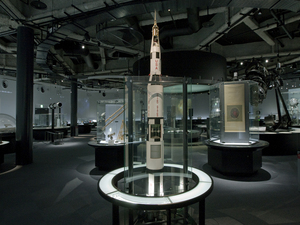Nagoya City Science Museum
TOP > Exhibition Guide > Keyword Search > Starting with "U" > United States > Exploration to the Moon
Exploration to the Moon



Purpose of Exhibition
Saturn V was a three stage, liquid-fueled rocket used by NASA under the Apollo program. 13 rockets were launched in total over a six-year period from 1968 to 1973. All launches succeeded, including Apollo 13, which failed to land on the moon due to an explosion of the oxygen tank. The Saturn V is the largest and most powerful rocket ever built, in terms of overall height, gross weight and payload.
This exhibit will show you the history of the challenge to the moon, with a model of the Saturn V rocket as the centerpiece, up to the 21st century, when humankind took its first steps to the moon and countries began to compete with each other to send explorers to the moon.
Additional Knowledge
[Space Race Era]
The challenge to the moon began with three unmanned programs: the Luna programme by the former Soviet Union, the Ranger and Surveyor programs of the United States. Most of the moon’s locations were mapped and manned exploration programs got underway.
The United States of America has successfully conducted a total of six manned missions to the moon, including Apollo 11, whereas the former Soviet Union failed to carry out a crewed mission due to a rocket engine explosion.
[Apollo program]
The Apollo program was initiated in 1961 with a historic speech by U.S. President John F. Kennedy: “I believe that this nation should commit itself to achieving the goal, before this decade is out, of landing a man on the moon and returning him safely to the earth.” It ran from 1961 until 1972, and at 5:17 a.m. on July21, 1968 (Japan time), Apollo 11 made the first successful landing on the moon. This was the first moment when humans reached a celestial body outside of the earth. During the entire Apollo program, a total of 6 spacecraft carried 12 astronauts to the lunar surface, and brought back a total of 381.7kg of moon rocks.
[Back to the Moon]
After that, there was no lunar exploration for a while, but in 1990, Japanese satellite, HITEN became the first spacecraft other than those of the United States and the former Soviet Union to orbit the moon. The US also sent an unmanned probe and surveyed the entire surface of the moon, creating a detailed map.
In 2007, Japan successfully launched the lunar orbiter KAGUYA, which made 15 different observations, such as surface composition and gravity anomalies, and produced a topographic map of the entire moon. KAGUYA captured beautiful images with High Definition Television System (HDTV), and has released them to the world.
China and India are also vigorously engaged in lunar exploration.
[Unsolved Mysteries]
There are still many mysteries about the moon, such as its size, the difference between the front and the back, and its internal structure. Firstly, compared to the satellites of other planets, the moon seems to be a disproportionately gigantic satellite for the earth. Secondly, the front side and the back side of the moon, that is to say, the side that we are always facing and the side that is hidden from us, are remarkably different. And, we don’t know if it has a metallic core like the earth’s.
This page was last edited on 22 June 2022.
Article by Astronomy Section
